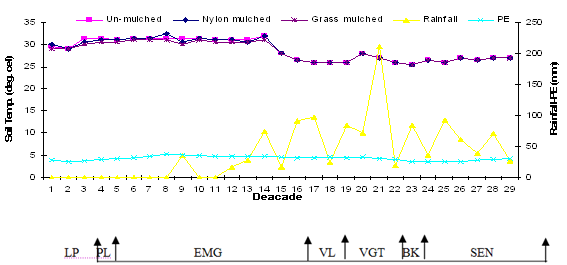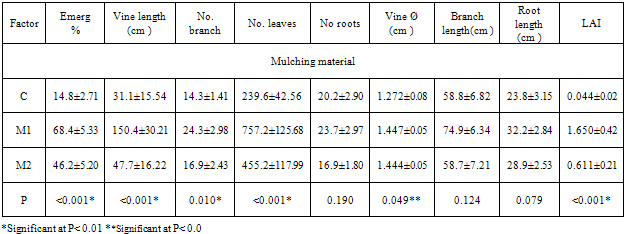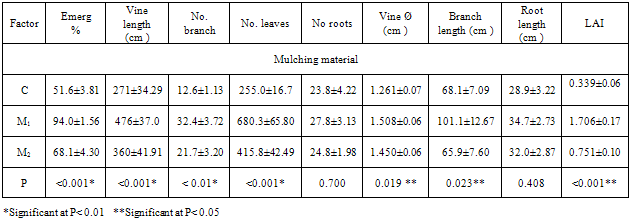-
Paper Information
- Next Paper
- Previous Paper
- Paper Submission
-
Journal Information
- About This Journal
- Editorial Board
- Current Issue
- Archive
- Author Guidelines
- Contact Us
International Journal of Agriculture and Forestry
p-ISSN: 2165-882X e-ISSN: 2165-8846
2012; 2(1): 93-100
doi: 10.5923/j.ijaf.20120201.15
Effect of Mulching on Soil Temperature and Moisture Regime on Emergence, Growth and Yield of White Yam in a Tropical Wet-and-Dry Climate
Eruola A. O 1, Bello N. J 1, Ufoegbune G. C 1, Makinde A. A 2
1University of Agriculture, Abeokuta, Nigeria
2National Horticultural Research Institute, Nigeria
Correspondence to: Eruola A. O , University of Agriculture, Abeokuta, Nigeria.
| Email: |  |
Copyright © 2012 Scientific & Academic Publishing. All Rights Reserved.
An on-farm yam experiment was conducted to study the effect of mulching on soil temperature and moisture regime on white yam (Dioscorea rotundata) growth and yield in Abeokuta, South-western Nigeria. Three mulching options (grass mulched, polythene mulched and unmulched) was selected and related to crop growth and yield. Grass mulch significantly (P < 0.05) lowered maximum soil temperature by 1-2℃ at 15cm depth during the thermal critical period (January - March). This led to higher rate of emergence which accounted for 28 and 46% to the polythene mulch and the unmulched plots respectively. Furthermore, grass mulch had tuber yield of about 4-6 tonnes ha-1 season-1 greater than the polythene mulch and the unmulched plots. Irrespective of mulching materials, it was found that mulching significantly (P< 0.05) increased tuber yield by about 6-8 tonnes ha-1 season-1 than the unmulched. The effect of grass mulch over nylon mulch on yam performance in the study was also discussed.
Keywords: Dioscorea Rotundata, Mulch, Temperature, Evaporation
Cite this paper: Eruola A. O , Bello N. J , Ufoegbune G. C , Makinde A. A , "Effect of Mulching on Soil Temperature and Moisture Regime on Emergence, Growth and Yield of White Yam in a Tropical Wet-and-Dry Climate", International Journal of Agriculture and Forestry, Vol. 2 No. 1, 2012, pp. 93-100. doi: 10.5923/j.ijaf.20120201.15.
Article Outline
1. Introduction
- Crop production in the tropics as in other parts of the world is sensitive to environmental factors[1]. Climatic factor appeared to be more marked both in terms of its variation over space and time[2]. The major climatic parameters involved in yam production are rainfall, temperature, light, and photoperiod[3,4]. However, moisture and temperature remains the most critical agro-meteorological factor for crop production in the tropics[5]. The occurrence of wet- season- dry spells which may last for a few days to more than three weeks is another serious limiting factor to agricultural management in South Western Nigeria. Incidence of wet season dry spells particularly during the full vegetative stage when evaporative demand is high can lead to retardation of yield formation. The damage is more severe for field crops with shallow root system[6]. However, for location with good soil moisture retention the plants may manage to utilize soil moisture reserve contained in the pores of the soil, or upon the very limited reserve contained in its own tissue during dry spells between rains. Crop may also adopt physiologically or behaviorally to prevent temporary depletion of the stored tissue moisture in other to prevent impairment of normal physiological function that may cause irreversible damage and plant death, more so that yam is highly susceptible to dry spells that occur during the onset of the rains and particularly before the rain has fully established. Therefore, since yam is planted between the period extending from around the cessation of the rains in a given year to the time of onset in the succeeding year, it implies therefore that as soon as germination starts, soil moisture become critical, hence the need for efficient soil moisture conservation strategy in other to optimize soil physical condition affecting the crop yield. Various techniques used by traditional farmers in modifying the on- farm microclimate and efficiency of such techniques in West Africa have been studied and reported[7-11].[12] reported that mulching is very important in yam cultivation. The beneficial effects of mulching on soil moisture and temperature, and growth and yield have been reported by[7,13,9][10].[14] reported that majority of the traditional yam farmers in West Africa use different mulching materials for yam cultivation. These materials range from dry grass, palm front to wood shaving. Of recent however, the[12] and some less conservative farmers were already using polythene plastic mulch in production of seed yam. However, research into the use of polythene plastic mulch in yam production is not widespread in Nigeria. This paper is an on-farm study and reports of changes in soil temperature and moisture regime and yam growth and yields that result when different types of mulch are applied.
 | Figure 1. Location of University of Agriculture, Abeokuta within Odeda Local Government Area in Ogun State, Southwestern Nigeria |
2. Materials and Methods
2.1. Description of Study Area
- The research was conducted at the Teaching and Research farm of University of Agriculture along Alabata road, Abeokuta (7o 15’N, 3o25’E) in Odeda Local Government Area of Ogun State, South Western Nigeria (fig. 1) during the 2007 and 2008 cropping seasons. The study area is characterized by a tropical climate with distinct wet and dry seasons with bimodal rainfall pattern and mean annual air temperature of about 30oC. The actual rainfall totals during the 2007 and 2008 cropping season were 1177.2 and 1201.6mm, respectively. The region is characterized by relatively high temperature with mean annual air temperature being about 30oC. The soil at the experimental site was categorized as a well-drained tropical ferruginous soil. The A horizon of the soil is an Oxic Paleudulf of the Iwo series with 83% sand, 5% silt and 12 % clay with a pH of 6 considered tolerable by yam cultivation[15].
2.2. Experimental Design and Field Measurement
- The experimental site, comprised of a piece of land (30 x 60m2) had previously carried beans and groundnut intercrop but had been fallowed for over 3 years (from 2004-2006). The site was cleared manually using cutlass in November 2006, in preparation for the 2007 cropping following the popular practice by the farmers in the study area. This period marks the preparatory period for the cultivation of early yam planting in the study area. Yam mounds were made manually using African hoe during the two experimental years. The mounds were of height 60cm and spaced 1.5 x 1.5m2 a walk way of 1m between adjacent row. The mound tillage system was selected for the study not only because it is the most widely use method in the study area, but also because it improves the soil aeration and hydrothermal conditions for crops emergence, root development, crop growth and yield[8].Three local white yam, Dioscorea rotundata cultivars (Efuru, ‘A1; Ise-osi ‘A2; and Oniyere ‘A3) were used. The choice of selection was due to the fact that the cultivars were the most important edible yams widely grown by farmers in the University’s extension villages around the study area. Two mulch materials namely; grass mulch (M1) and Polythene nylon (M2) were used. About 40cm diameter of each mound was covered with dry grass mulch and polythene nylon of an average size of 70 x 50cm2 was used. The polythene nylon was perforated and has the side covering the mound as black surface and white surface facing the atmosphere. This was adopted in other to regulate the soil temperature. The black surface is to conserve the Long Wave Radiation while the white surface facing up is to reflect excessive Short Wave Radiation. However, mulching was done after planting usually between 6.30-7.30 am when radiation intensity was nil (in other words before sunrises, when the Cambell Stokes Sunshine recorder was unable to receive enough radiation to burn the Sunshine recording card). In addition to the mulched plot, an un-mulch treatment was included in the experiment which served as control (C). In other to achieve a proper sprouting and aeration of setts and effective roots development, the mulching materials were removed from mounds during the humid period. This period coincided with the early tuber formation stage of yam. This period according to[15] is the time when most traditional farmers in West Africa normally remove mulch materials. According to his work, it revealed that if the mulch materials are not removed during the tuber formation stage, it will prevent the infiltration of rainwater to encourage good tuberization.During each of the phenological stages, daily observation of air and soil temperature (oC) at 15 and 25cm depth and rainfall (mm) were made at meteorological enclosure adjacent to the experimental field. Phenological crop growth parameter and yield characters were also measured. Data collected were subjected to analysis of variance (ANOVA) using GenStat Release 7.2 statistical software (Discovery Edition 3) to evaluate the effects of “mulching and mulching materials”. The significant difference of treatment means were determined using least significance difference (LSD) 5% level of probability[16].
3. Results and Discussion
- The study showed that mulching significantly improves soil temperature in both experimental years. The decadal cycle of soil temperature under different mulching method and mulching materials (un mulch, nylon mulch and grass mulch) measured at 15cm and 25cm depth at the different phenological stages of white yam in the study area in 2007 is as shown in fig. 2 and 3. The soil temperature ranges from 26 to 32oC for 15cm depth and 25.5- 32.5 oC for 25cm depth all through the 2007 cropping seasons. The difference in soil temperature at 15cm and 25cm depth under the different mulching methods were noticed at the arid periods between the 1st to 15th decade, however, the similar soil temperature experienced during the humid period between 18th to 29th decade were as a result of the removal of all the mulches at the beginning of the humid period at the 18th decade for 2007. The soil temperature for 2007 cropping season was observed to be similar from the 1st and 5th decades under un-mulched and nylon mulched, whereas the grass mulched soil plot was lower by temperature range of 1- 2oC, this period coincides with the planting and early emergence period. However, for period from 5th to 15th decade which marked the emergence to early vine elongation, the mulched plots gave lower temperature range than the un-mulched plots. The soil temperature range under the grass and nylon mulched soil were similar, while the higher range was observed during this periods under the un-mulched soil with values ranging from 31-32.5oC, this coincided with the decade that the rainfall was less than or equal to the potential evapotranspiration (P≤ PE). This suggested that mulching reduced the amount of radiant flux reaching the soil surface and probably minimized heat loss by evaporation. However, for the remaining stages of crop for the same year (2007), the same amount of soil temperature was observed all through the planting season. This similarity was as a result of the removal of mulches at this period. The soil temperature was low and ranged between 26.5 to 28oC at 15 cm depth.
|
|
|
|
4. Conclusions and Recommendations
- From this study, it is obvious that mulching significantly improves soil temperature, the emergence and development of yam setts and increased tuber yield. The physical effect of the mulch, through reducing nutrient losses by runoff, erosion and leaching and decreasing maximum soil temperature and conserving moisture may have increased growth and tuber yield as compared to un-mulch. The result of the study further revealed that the type of mulching material used also influences the emergence, development and yield of yam. The grass mulch has significantly lower soil temperature and produced higher yield than the polythene mulch. One chemical effect of grass mulch over nylon mulch on yam performance in the study might be the release of nutrients, particularly the nitrogen and phosphorous from decomposed grass while on the other hand the polythene mulch is not biodegradable. However, both mulches have the physical effect of reduction of nutrient losses by surface erosion and leaching and also checks weed growth.
 Abstract
Abstract Reference
Reference Full-Text PDF
Full-Text PDF Full-Text HTML
Full-Text HTML






